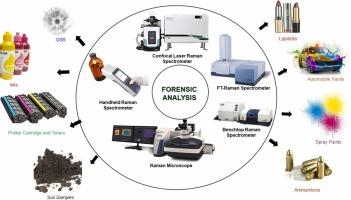用拉曼光谱分析痕量物质的系统综述:进展和法医学意义
IF 2.5
3区 医学
Q1 MEDICINE, LEGAL
引用次数: 0
摘要
拉曼光谱,辅以先进的技术,如表面增强拉曼光谱(SERS)和微拉曼光谱,正在日益扩大其在分析痕量材料的法医应用。由于其简单、快速、非破坏性和最少或不需要样品制备,法医从业者正在更广泛地采用它。尽管有一定的局限性,如相对较低的灵敏度和显著的荧光干扰,拉曼光谱已经大大增强了先进的技术,如SERS和共振拉曼光谱,有效地缓解了这些问题,并有助于释放拉曼分析的全部潜力。本文收集了来自web of Science、Scopus和谷歌scholar三个主要数据库的大量数据,以展示拉曼光谱技术在痕量样品的法医分析中的应用,特别是在墨水、染料、枪击残留物、油漆和相关物质的检测中。研究表明,拉曼光谱技术大大简化了法医痕迹的分析,为广泛的痕迹现场检测提供了一种有前途的方法,提高了效率和准确性。本文章由计算机程序翻译,如有差异,请以英文原文为准。

A systematic review on the analysis of trace materials via Raman spectroscopy: Advancements and forensic implications
Raman spectroscopy, complemented by advanced techniques such as surface-enhanced Raman spectroscopy (SERS) and micro-Raman spectroscopy, is increasingly expanding its forensic applications in analysing trace materials. Forensic practitioners are adopting it more widely due to its simplicity, speed, non-destructive nature, and minimal or no sample preparation required. Despite certain limitations, such as relatively low sensitivity and significant fluorescence interference, Raman spectroscopy has been greatly enhanced by advanced techniques like SERS and Resonance Raman Spectroscopy, which effectively mitigate these issues and help unlock the full potential of Raman analysis. This review compiles extensive data from three major databases—Web of Science, Scopus, and Google Scholar—to demonstrate the utility of Raman spectroscopic techniques in the forensic analysis of trace samples, particularly in the examination of inks, dyes, gunshot residues, paints, and related substances. The study shows that Raman spectroscopy has significantly simplified the analysis of forensic traces, offering a promising approach for the on-site examination of a wide range of traces with improved efficiency and accuracy.
求助全文
通过发布文献求助,成功后即可免费获取论文全文。
去求助
来源期刊

Forensic science international
医学-医学:法
CiteScore
5.00
自引率
9.10%
发文量
285
审稿时长
49 days
期刊介绍:
Forensic Science International is the flagship journal in the prestigious Forensic Science International family, publishing the most innovative, cutting-edge, and influential contributions across the forensic sciences. Fields include: forensic pathology and histochemistry, chemistry, biochemistry and toxicology, biology, serology, odontology, psychiatry, anthropology, digital forensics, the physical sciences, firearms, and document examination, as well as investigations of value to public health in its broadest sense, and the important marginal area where science and medicine interact with the law.
The journal publishes:
Case Reports
Commentaries
Letters to the Editor
Original Research Papers (Regular Papers)
Rapid Communications
Review Articles
Technical Notes.
 求助内容:
求助内容: 应助结果提醒方式:
应助结果提醒方式:


